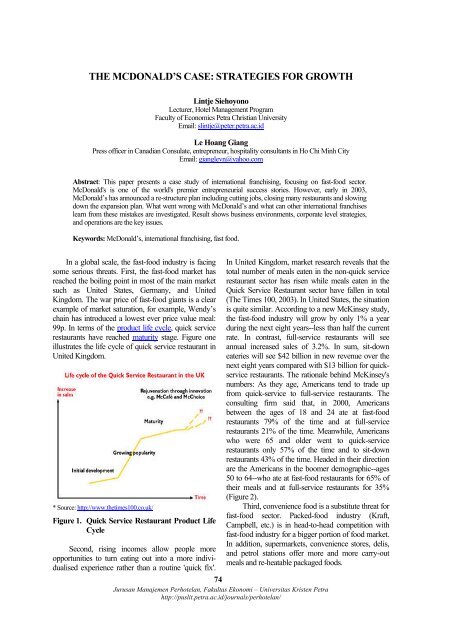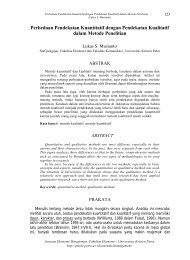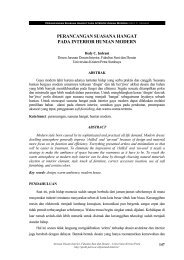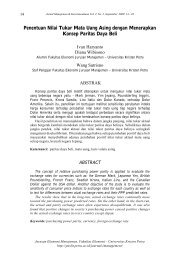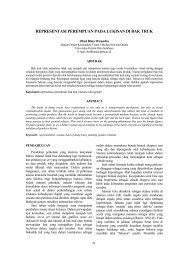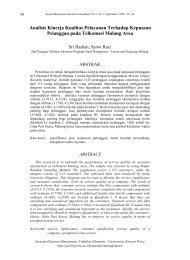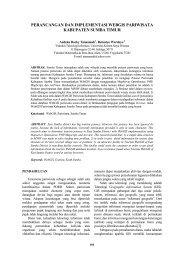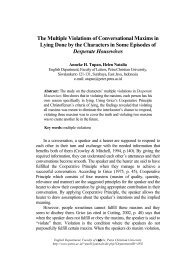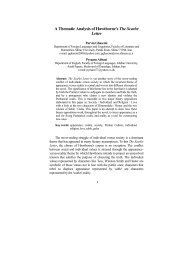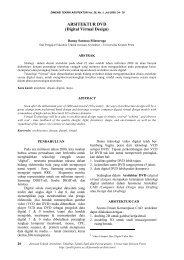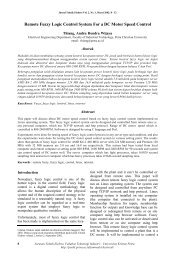the mcdonald's case: strategies for growth - Puslit Petra - Universitas ...
the mcdonald's case: strategies for growth - Puslit Petra - Universitas ...
the mcdonald's case: strategies for growth - Puslit Petra - Universitas ...
You also want an ePaper? Increase the reach of your titles
YUMPU automatically turns print PDFs into web optimized ePapers that Google loves.
THE MCDONALD’S CASE: STRATEGIES FOR GROWTH<br />
Lintje Siehoyono<br />
Lecturer, Hotel Management Program<br />
Faculty of Economics <strong>Petra</strong> Christian University<br />
Email: slintje@peter.petra.ac.id<br />
Le Hoang Giang<br />
Press officer in Canadian Consulate, entrepreneur, hospitality consultants in Ho Chi Minh City<br />
Email: gianglevn@yahoo.com<br />
Abstract: This paper presents a <strong>case</strong> study of international franchising, focusing on fast-food sector.<br />
McDonald's is one of <strong>the</strong> world's premier entrepreneurial success stories. However, early in 2003,<br />
McDonald’s has announced a re-structure plan including cutting jobs, closing many restaurants and slowing<br />
down <strong>the</strong> expansion plan. What went wrong with McDonald’s and what can o<strong>the</strong>r international franchises<br />
learn from <strong>the</strong>se mistakes are investigated. Result shows business environments, corporate level <strong>strategies</strong>,<br />
and operations are <strong>the</strong> key issues.<br />
Keywords: McDonald’s, international franchising, fast food.<br />
In a global scale, <strong>the</strong> fast-food industry is facing<br />
some serious threats. First, <strong>the</strong> fast-food market has<br />
reached <strong>the</strong> boiling point in most of <strong>the</strong> main market<br />
such as United States, Germany, and United<br />
Kingdom. The war price of fast-food giants is a clear<br />
example of market saturation, <strong>for</strong> example, Wendy’s<br />
chain has introduced a lowest ever price value meal:<br />
99p. In terms of <strong>the</strong> product life cycle, quick service<br />
restaurants have reached maturity stage. Figure one<br />
illustrates <strong>the</strong> life cycle of quick service restaurant in<br />
United Kingdom.<br />
* Source: http://www.<strong>the</strong>times100.co.uk/<br />
Figure 1. Quick Service Restaurant Product Life<br />
Cycle<br />
Second, rising incomes allow people more<br />
opportunities to turn eating out into a more individualised<br />
experience ra<strong>the</strong>r than a routine 'quick fix'.<br />
In United Kingdom, market research reveals that <strong>the</strong><br />
total number of meals eaten in <strong>the</strong> non-quick service<br />
restaurant sector has risen while meals eaten in <strong>the</strong><br />
Quick Service Restaurant sector have fallen in total<br />
(The Times 100, 2003). In United States, <strong>the</strong> situation<br />
is quite similar. According to a new McKinsey study,<br />
<strong>the</strong> fast-food industry will grow by only 1% a year<br />
during <strong>the</strong> next eight years--less than half <strong>the</strong> current<br />
rate. In contrast, full-service restaurants will see<br />
annual increased sales of 3.2%. In sum, sit-down<br />
eateries will see $42 billion in new revenue over <strong>the</strong><br />
next eight years compared with $13 billion <strong>for</strong> quickservice<br />
restaurants. The rationale behind McKinsey's<br />
numbers: As <strong>the</strong>y age, Americans tend to trade up<br />
from quick-service to full-service restaurants. The<br />
consulting firm said that, in 2000, Americans<br />
between <strong>the</strong> ages of 18 and 24 ate at fast-food<br />
restaurants 79% of <strong>the</strong> time and at full-service<br />
restaurants 21% of <strong>the</strong> time. Meanwhile, Americans<br />
who were 65 and older went to quick-service<br />
restaurants only 57% of <strong>the</strong> time and to sit-down<br />
restaurants 43% of <strong>the</strong> time. Headed in <strong>the</strong>ir direction<br />
are <strong>the</strong> Americans in <strong>the</strong> boomer demographic--ages<br />
50 to 64--who ate at fast-food restaurants <strong>for</strong> 65% of<br />
<strong>the</strong>ir meals and at full-service restaurants <strong>for</strong> 35%<br />
(Figure 2).<br />
Third, convenience food is a substitute threat <strong>for</strong><br />
fast-food sector. Packed-food industry (Kraft,<br />
Campbell, etc.) is in head-to-head competition with<br />
fast-food industry <strong>for</strong> a bigger portion of food market.<br />
In addition, supermarkets, convenience stores, delis,<br />
and petrol stations offer more and more carry-out<br />
meals and re-heatable packaged foods.<br />
74<br />
Jurusan Manajemen Perhotelan, Fakultas Ekonomi – <strong>Universitas</strong> Kristen <strong>Petra</strong><br />
http://puslit.petra.ac.id/journals/perhotelan/
* Source: http://www.businessweek.com/1998/10/b3568001.htm<br />
Figure 2. Where <strong>the</strong> United States Eats Out, 2000<br />
Last but not least, <strong>the</strong> biggest threat appears to<br />
come from an increasing awareness among<br />
consumers of <strong>the</strong> benefits of healthy eating. Nutrition<br />
and health studies and reports have heightened public<br />
concern over <strong>the</strong> fat and sodium content of fast foods.<br />
Moreover, a Euro monitor report published in<br />
November, found that "a sandwich is viewed by <strong>the</strong><br />
majority of consumers as an inherently healthier<br />
product than burgers, chicken, fish and chips, or<br />
many o<strong>the</strong>r fast-food sub-sectors. Consequently, in<br />
1990, burger consumption dropped to 17 percent of<br />
all restaurant orders, from 19 percent in 1982<br />
(Lewison, 1994). As <strong>the</strong> results from a<strong>for</strong>ementioned<br />
unfavorable trends, sales <strong>growth</strong> has slowed in <strong>the</strong><br />
fast-food market from 7.1 percent in <strong>the</strong> 1970s to 4.9<br />
percent in <strong>the</strong> 1980s to 3.0 percent in 1990 (Lewison,<br />
1994).<br />
McDonald's is one of <strong>the</strong> world's premier<br />
entrepreneurial success stories in fast food industry.<br />
However, early in 2003, McDonald has announced a<br />
re-structure plan including cutting jobs, closing many<br />
restaurants and slowing down <strong>the</strong> expansion plan.<br />
From all phenomena mentioned above, particularly<br />
what has happened to McDonald’s, what went wrong<br />
with McDonald’s and what can o<strong>the</strong>r international<br />
franchises learn from <strong>the</strong>se mistakes are investigated<br />
in this paper.<br />
MCDONALD’S HISTORY: GOLDEN ARCHES<br />
“Whatever people ate, McDonald's would be <strong>the</strong><br />
ones to sell it”<br />
Ray Kroc's: McDonald’s Founder<br />
McDonald's Corporation is <strong>the</strong> world's largest<br />
chain of fast-food restaurants. Although McDonald's<br />
did not invent <strong>the</strong> hamburger or <strong>the</strong> fast-food<br />
Siehoyono, The Mcdonald’s Case: Strategies <strong>for</strong> Growth<br />
restaurant, <strong>the</strong>ir name has become nearly synonymous<br />
with both. The history of McDonald’s began in<br />
1940 when bro<strong>the</strong>rs Dick and Mac McDonald<br />
opened <strong>the</strong> first restaurant in San Bernardino,<br />
Cali<strong>for</strong>nia. The McDonald's restaurant gained fame<br />
after 1948, when <strong>the</strong> bro<strong>the</strong>rs implemented <strong>the</strong>ir<br />
innovative "Speedee Service System", an assemblyline<br />
hamburger construction and self-serve operation.<br />
In 1954, entrepreneur and milkshake-mixer<br />
salesman Ray Kroc became interested in <strong>the</strong><br />
McDonald's restaurant when he learned of its<br />
extraordinary capacity. Upon seeing <strong>the</strong> restaurant in<br />
operation, he approached <strong>the</strong> McDonald bro<strong>the</strong>rs<br />
with a proposition to open new McDonald's<br />
restaurants, with himself as <strong>the</strong> first franchisee. Kroc<br />
worked hard to sell McDonald's. He even attempted<br />
to overcome on his wartime in connection with Walt<br />
Disney, in <strong>the</strong> failed hope of opening a McDonald's at<br />
<strong>the</strong> soon-to-be-opened Disneyland. Eventually he<br />
opened his first restaurant in Des Plaines, Illinois. It<br />
was an immediate success.<br />
Kroc's new company was originally named<br />
"McDonald's Systems Inc.", and was founded March<br />
2, 1955. In 1960, <strong>the</strong> company was renamed<br />
"McDonald's Corporation". One of Kroc's marketing<br />
insights was his decision to market McDonald's<br />
hamburgers to families, and particularly to children.<br />
In <strong>the</strong> early 1960s, a Washington, DC McDonald's<br />
franchisee named Oscar Goldstein sponsored a<br />
children's show called Bozo's Circus, starring a clown<br />
played by Willard Scott. When <strong>the</strong> show was<br />
cancelled, Goldstein hired Scott as McDonald's new<br />
mascot, "Ronald McDonald’s". The character was<br />
eventually spread to <strong>the</strong> rest of <strong>the</strong> country via an<br />
advertising campaign, although it was decided that<br />
Scott was too plump <strong>for</strong> <strong>the</strong> role. Under Kroc's<br />
agreement with <strong>the</strong> McDonald bro<strong>the</strong>rs, he was<br />
responsible <strong>for</strong> <strong>the</strong> entire expansion process, while <strong>the</strong><br />
bro<strong>the</strong>rs retained control of <strong>the</strong> production process<br />
and a share of <strong>the</strong> profits. By 1961, Kroc was<br />
frustrated with <strong>the</strong> arrangement. After some<br />
negotiation, <strong>the</strong> com<strong>for</strong>tably wealthy McDonald<br />
bro<strong>the</strong>rs agreed to sell Kroc <strong>the</strong> business rights to<br />
<strong>the</strong>ir operation <strong>for</strong> $2.7 million, which was borrowed<br />
from a number of investors. Since that time,<br />
McDonald's has opened restaurants in countries<br />
throughout <strong>the</strong> world. On January 31, 1990 <strong>the</strong> first<br />
McDonald's Restaurant opened in Moscow, Russia.<br />
In contrast to <strong>the</strong> stereotype of McDonald’s in <strong>the</strong><br />
United States in which McDonald’s is seen as <strong>the</strong><br />
source of cheap, inferior, and unhealthy food, in some<br />
parts of <strong>the</strong> world such as Russia and China,<br />
McDonald's food is seen as a status symbol and <strong>the</strong><br />
restaurants are admired <strong>for</strong> <strong>the</strong>ir atmosphere and<br />
cleanliness (Wikipedia.com, 2003).<br />
Jurusan Manajemen Perhotelan, Fakultas Ekonomi – <strong>Universitas</strong> Kristen <strong>Petra</strong><br />
http://puslit.petra.ac.id/journals/perhotelan/<br />
75
76<br />
JURNAL MANAJEMEN PERHOTELAN, VOL. 1, NO. 2, SEPTEMBER 2005: 74-79<br />
Today, McDonald’s remains <strong>the</strong> king of fast food<br />
with 31,000 restaurants in 121 countries. In 2001,<br />
<strong>the</strong>y served over 16 billion customers, equivalent to a<br />
lunch and dinner <strong>for</strong> every man, woman and child in<br />
<strong>the</strong> world! McDonald's global sales were over<br />
$38billions, making it by far <strong>the</strong> largest food service<br />
company in <strong>the</strong> world, which made it <strong>the</strong> world’s<br />
366 th largest company measured by revenues. The<br />
company operates o<strong>the</strong>r restaurant brands, such as<br />
Aroma Café, Boston Market, Chipotle Mexican Grill,<br />
Donatos Pizza and Pret A Manger. As part from its<br />
food, <strong>the</strong> chain is famous <strong>for</strong> <strong>the</strong> way that all staff are<br />
trained in its distinctive operating procedures, at <strong>the</strong><br />
company’s own “Hamburger University”. In 2002, it<br />
was <strong>the</strong> world’s 10 th largest employer, with 395,000<br />
employees worldwide (Fortune, 2002).<br />
In term of revenue between year 2000-2003,<br />
United States’ operation contributes <strong>the</strong> highest<br />
portion follows with Europe (except in 2004, Europe<br />
is at <strong>the</strong> highest share) and Asia Pacific, Middle East<br />
and Africa (Table 1). McDonald’s owned 43% of <strong>the</strong><br />
hamburger fast-food market followed by Burger King<br />
with 19% and Wendy’s with 13% (Trends Setter,<br />
2002).<br />
Table 1. Distribution of Revenue (dollars in<br />
millions)<br />
2004 2003 2002 2001 2000<br />
U.S. $6,526 6,039 5,423 5,396 5,259<br />
Europe 6,736 5,875 5,136 4,752 4,754<br />
APMEA 2,721 2,447 2,368 2,203 2,102<br />
Latin America 1,007 859 814 971 949<br />
Canada 898 778 633 608 615<br />
Partner<br />
Branded<br />
1,1756 1,142 1032 940 564<br />
Total Revenue 19,065 17,141 15,406 14,870 14,243<br />
* Source: McDonald’s annual report, http://www.mcdonalds.<br />
com/<br />
Despite <strong>the</strong> favourable economic <strong>growth</strong> in<br />
1980’s and early 1990’s, McDonald’s had a precise<br />
expansion strategy from <strong>the</strong> starting point. Ray Kroc<br />
realized that <strong>the</strong> key to success was rapid expansion<br />
through internalization. The best way to achieve this<br />
was by applying <strong>for</strong>ward integration strategy through<br />
offering franchises. Kotler (2003, p. 101) claimed that<br />
sales and profit of a business can be accelerated<br />
through <strong>for</strong>ward integration in its industry in which it<br />
may get hold of some retailers or wholesalers,<br />
particularly <strong>the</strong>y are highly profitable (franchisee).<br />
Today, over 70 percent of McDonald's restaurants are<br />
run on this basis (The Times 100, 2002). As shown in<br />
table 1, approximately above 63% of total revenue is<br />
from overseas operation. For most of <strong>the</strong> world’s<br />
inhabitants, McDonald’s is globalisation. To a larger<br />
extent, McDonald’s is looking <strong>for</strong> homogeneous<br />
consumer groups and replicating <strong>the</strong> same <strong>for</strong>mat in<br />
<strong>for</strong>eign countries, making only minor changes to suit<br />
<strong>the</strong> local or national preferences but recognizably<br />
maintaining <strong>the</strong> original concept (Helfferich et al,<br />
1997). Illustration can be seen through extensive<br />
menu development in many countries <strong>for</strong> instance<br />
beside <strong>the</strong> original ones, McLarks in Norway, a<br />
grilled salmon sandwich with dill sauce on a whole<br />
grain bread, Groenteburger in <strong>the</strong> Ne<strong>the</strong>rlands,<br />
Samurai pork burger in Thailand, Chicken Tatsuata<br />
sandwich in Japan and many more (Ritzer, 1998).<br />
Despite <strong>the</strong> diverse environments in which it<br />
operates and <strong>the</strong> fact that many of its restaurant are<br />
managed by franchises, until 1997 most outlets were<br />
operated using <strong>the</strong> same reward systems, <strong>the</strong> same<br />
hierarchical management structure, and <strong>the</strong> same<br />
routine <strong>for</strong> serving food. McDonald’s centralized <strong>the</strong><br />
design of its service concept, restaurant layout, <strong>the</strong><br />
selection of franchisees and o<strong>the</strong>r personnel, and <strong>the</strong><br />
design and content of training of restaurant managers<br />
and staff. The company is an enterprise with 900page<br />
manual and 36,000 regulations <strong>for</strong> its huge<br />
number of stores. The standardization of McDonalds<br />
has been emblematic of globalisation (Love, 1986).<br />
Adding to its success, <strong>the</strong> McDonald's Corporation's<br />
business model is slightly different from that<br />
of most o<strong>the</strong>r fast-food chains. In addition to ordinary<br />
franchise fees, supplies and percentage of sales,<br />
McDonald's also collects rent. As a condition of <strong>the</strong><br />
franchise agreement, McDonald's owns <strong>the</strong> property<br />
on which most McDonald's franchises are located.<br />
The corporation extracts income from <strong>the</strong> franchises<br />
in <strong>the</strong> <strong>for</strong>m of rents, which are only partially linked to<br />
sales. As Harry J. Sonneborne, one of McDonald's<br />
founders put it, "We are in <strong>the</strong> real estate business.<br />
The only reason we sell hamburgers is because <strong>the</strong>y<br />
are <strong>the</strong> greatest producer of revenue from which our<br />
tenants can pay us rent." Today, franchisees pay<br />
about 12% of <strong>the</strong> average units $1.6 million sales in<br />
rent and ano<strong>the</strong>r 4% in royalties. In addition, <strong>the</strong>y also<br />
share marketing costs and buy some of <strong>the</strong>ir suppliers<br />
from headquarters (Forbes, 2001). Such strategy<br />
(<strong>for</strong>ward integration), structure (different business<br />
model), and uni<strong>for</strong>mity (reward systems, hierarchical<br />
management structure, routine in serving food) have<br />
made McDonald’s <strong>the</strong> brand name that defined<br />
American fast food.<br />
MCDONALD’S: FALLEN ARCHES<br />
Obviously, McDonald’s is globalisation. But that<br />
is perhaps <strong>the</strong> point: globalization has not turned out<br />
to be all that simple an affair. In 2002, McDonald’s<br />
posted its first loss as a result of <strong>the</strong> failure of <strong>the</strong><br />
company’s attempt to diversify. For <strong>the</strong> full year,<br />
Jurusan Manajemen Perhotelan, Fakultas Ekonomi – <strong>Universitas</strong> Kristen <strong>Petra</strong><br />
http://puslit.petra.ac.id/journals/perhotelan/
earnings were $893.5 million, down 45 per cent from<br />
$1.64 billion in 2001. Revenue rose 2 per cent to<br />
$41.53 billion (2001-2002), although sales <strong>for</strong><br />
restaurants open at least a year dipped 2.1 per cent<br />
(McDonald’s financial report, 2002). It shows a<br />
remarkable turn down in sales after year 2000 (table<br />
2). The sales in 2002 dropped to $2.1 billion ($1.3<br />
billion less than year 2000). In particular, with an<br />
exception of France, sales at stores open at least a<br />
year declined in its five biggest markets, U.S.,<br />
Germany, Britain and Japan (Trend Setters, 2003).<br />
Since 1987, McDonald's share of fast-food sales in<br />
<strong>the</strong> U.S. has slipped almost two percentage points, to<br />
16.2%. The drop has come even as <strong>the</strong> company has<br />
increased its number of restaurants by 50%, far<br />
outpacing <strong>the</strong> industry's expansion rate.<br />
Table 2. McDonald’s Revenue (dollars in millions)<br />
2004 2003 2002 2001 2000<br />
Total Revenue $19,065 17,140 15,406 14,870 14,243<br />
Operating Income 3,541 2,832 2,113 2,697 3,330<br />
Net Income 2,279 1,471 893 1,637 1,977<br />
* Source: McDonald’’s financial report 2004, http://www.mcdonalds.com/<br />
In 2003, McDonald’s had revealed that it<br />
planned to pull out of three countries and to subject<br />
franchisees in four o<strong>the</strong>r countries to an ownership<br />
restructuring. In addition, McDonald’s aimed to close<br />
175 underper<strong>for</strong>ming outlets in ten o<strong>the</strong>r nations and<br />
"eliminate" between 400 and 600 staff from its payroll<br />
worldwide, including 200 to 250 jobs<br />
domestically. The company’s shares fell 7.9 per cent<br />
to $17.79 on <strong>the</strong> New York Stock Exchange after <strong>the</strong><br />
announcement (News Scotsman, 2003).<br />
Table 3. Stock Per<strong>for</strong>mance of <strong>the</strong> World's Top<br />
Six Brands<br />
BRAND 2-YEAR TOTAL RETURN<br />
Coca-Cola 71%<br />
Eastman Kodak -8<br />
Gillette 101<br />
McDonald's 3<br />
Sony 49<br />
Walt Disney 78<br />
S&P 500 Average 63<br />
* Source: Interbrand, Bloomberg Financial Markets. Cited in<br />
Businessweek.com (1998)<br />
Moreover, investors are not happy by any means<br />
with <strong>the</strong> company per<strong>for</strong>mance. As shown in table 3,<br />
over <strong>the</strong> past two years, while <strong>the</strong> Standard & Poor's<br />
500-stock index grew by 63%, McDonald's shareholders<br />
could have made more money. Had you<br />
invested $100 in <strong>the</strong> company two years ago, you'd<br />
be holding $103 today. Of <strong>the</strong> world's 10 most<br />
powerful brands, as ranked by Interbrand, a New<br />
Siehoyono, The Mcdonald’s Case: Strategies <strong>for</strong> Growth<br />
York consultant, only Eastman Kodak Co. has had a<br />
worse run over that period. Shareholders of Gillette<br />
Co., meanwhile, have more than doubled <strong>the</strong>ir<br />
money.<br />
What is more, McDonald’s is confronting with<br />
even more fundamental problem: <strong>the</strong> quality of its<br />
food. While <strong>the</strong> company focused on building more<br />
stores, consumers have decided <strong>the</strong>y want better food<br />
and more variety. Consumers who eat fast food at<br />
least once a month say that both Wendy's and Burger<br />
King offer better-tasting fare, according to a recent<br />
Business Week/Harris Poll (Table 4) and in a soonto-be-released<br />
survey <strong>for</strong> Restaurants & Institutions<br />
magazine in which 2,800 consumers graded chains<br />
based on <strong>the</strong> taste of <strong>the</strong>ir food, McDonald's ranked<br />
87 th out of 91 st . Likewise, according to <strong>the</strong> Harris Poll<br />
more than 90% of consumers listed both taste and<br />
quality as ''very important'' factors in <strong>the</strong>ir choice of a<br />
restaurant, while location and speed were selected by<br />
barely half. Convenience, <strong>the</strong>re<strong>for</strong>e, is no longer<br />
enough. With an abundance of choices, consumers no<br />
longer choose McDonald's just because <strong>the</strong>re is one<br />
around <strong>the</strong> corner. In addition, with new entrants<br />
offering ethnic fare, vegetarian menus, and fully<br />
stocked salad bars, fast food no longer has to mean<br />
fried food (Businessweek.com, 1998).<br />
Table 4. Consumer Survey<br />
The Best Tasting Food The Best Tasting Burgers<br />
Wendy's 36% Burger King 42%<br />
Burger King 32% Wendy's 32%<br />
McDonald's 21% McDonald's 17%<br />
O<strong>the</strong>r 8% O<strong>the</strong>r 7%<br />
Don't know 2% Don't know 2%<br />
(Note: Results cover only those who say <strong>the</strong>y eat fast food at least<br />
once a month.)<br />
* Source: Business Week, http://www.businessweek.com/1998/<br />
10/b3568001.htm<br />
Consequently, Eric Schlosser, whose devastating<br />
book on <strong>the</strong> "all-American meal", Fast Food Nation,<br />
swept <strong>the</strong> world last year, compared McDonald’s<br />
position with that of <strong>the</strong> British Empire just be<strong>for</strong>e <strong>the</strong><br />
First World War. "If you looked at a map, half <strong>the</strong><br />
world was colored pink. But <strong>the</strong>re were all sorts of<br />
problems lurking beneath <strong>the</strong> surface," he claimed<br />
(News Scotsman, 2003).<br />
ANALYSIS AND DISCUSSION<br />
What went wrong: management, strategy or<br />
operation?<br />
Apparently, McDonald’s has to deal with several<br />
issues regarding <strong>the</strong> decline in per<strong>for</strong>mance. The<br />
writers analyze that first, in spite of <strong>the</strong> unfavorable<br />
market condition at <strong>the</strong> macro level <strong>for</strong> McDonald’s<br />
such as <strong>the</strong> mad cow disease in Europe, global wave<br />
Jurusan Manajemen Perhotelan, Fakultas Ekonomi – <strong>Universitas</strong> Kristen <strong>Petra</strong><br />
http://puslit.petra.ac.id/journals/perhotelan/<br />
77
78<br />
JURNAL MANAJEMEN PERHOTELAN, VOL. 1, NO. 2, SEPTEMBER 2005: 74-79<br />
of anti-US sentiment; <strong>the</strong> first issue comes from <strong>the</strong><br />
inside: <strong>the</strong> company management approach. Mc-<br />
Donald's has largely clung to <strong>the</strong> ''McFamily''<br />
philosophy of <strong>the</strong> 1950s and 1960s, which rewards<br />
managers who start young and stay <strong>for</strong> life. Managers<br />
who had spent ten years at <strong>the</strong> firm were still regarded<br />
as new. Moreover, this long-serving headquarter staff<br />
were taking many operating decisions, <strong>for</strong> example<br />
on pricing, without reference to franchisees or to<br />
consumer research data (Financial Times, 1998). As a<br />
result, management team was very conservative to<br />
adapt with <strong>the</strong> market changes and on top of it, <strong>the</strong>y<br />
were too confident about McDonald’s capacities.<br />
Second, <strong>the</strong> rapid expansion strategy was an<br />
appropriate corporate strategy level in <strong>the</strong> past<br />
however not anymore. Compare <strong>the</strong> McDonald's<br />
strategy with that at o<strong>the</strong>r companies that have<br />
prospered despite wrenching changes in <strong>the</strong>ir<br />
industries. When GE realized that manufacturing had<br />
become less profitable, it moved into financing.<br />
When Walt Disney Co. found it hard to attract more<br />
people to its <strong>the</strong>me parks, it built hotels and captured<br />
more dollars from <strong>the</strong> tourists already <strong>the</strong>re. And<br />
Coca-Cola spun off its bottling business and focused<br />
instead on becoming a marketing powerhouse<br />
(Business Week, 1998). These companies (GE,<br />
Disneyland and Coca Cola) have applied <strong>the</strong><br />
horizontal diversification strategy in which <strong>the</strong><br />
companies develop new products that are dissimilar<br />
to <strong>the</strong>ir existing product line technologically but may<br />
possibly appeal to current customers (Hunger &<br />
Wheelen, 2003, p. 104; Kotler, 2003, p. 101). As<br />
described in term of Ansoff’s product-market<br />
expansion grid, McDonald’s should have developed<br />
diversification strategy ra<strong>the</strong>r than consolidating <strong>the</strong><br />
market share in decline-<strong>growth</strong> of fast-food sector<br />
(Fleisher & Bensoussan, 2003, p.335; Kotler, 2003,<br />
pp. 100-101). This can be seen through <strong>the</strong> price war<br />
such as 39 cent cheese burger was aimed to maintain<br />
and gain more market share from its rivals.<br />
Importantly, by applying <strong>the</strong> well-known<br />
analyzing tool of Porter’s Five Forces Model,<br />
namely (1) threat of new entrants; (2) bargaining<br />
power of supplier; (3) threat of substitutes; (4)<br />
bargaining power of buyers and; (5) intensity of<br />
rivalry (Fleisher & Bensoussan, 2003, p.68; David,<br />
2003, p. 121), McDonald’s was pressed from many<br />
different directions. It goes without saying that <strong>the</strong><br />
capital requirement of entry and legislation are low<br />
and uncomplicated and thus <strong>the</strong> threat of entry is<br />
considered low fast-food sector. There is a glut of<br />
outlets resulting in over-capacity and over-stored<br />
conditions in many of <strong>the</strong> country’s prime trading<br />
areas. According to Lewison (1994), <strong>the</strong>re are 3,700<br />
new outlets being built each year in U.S. Noticeably,<br />
<strong>the</strong> power of suppliers was not a big issue <strong>for</strong><br />
McDonald’s. The power of consumer, however, was<br />
a significant aspect to McDonald’s. Consumers are<br />
becoming more concerned about <strong>the</strong> nutrition and<br />
health. Menu items high in fat, sodium, and<br />
cholesterol are inconsistent with <strong>the</strong> changing<br />
consumer behavior pattern. As said by Take Stephen<br />
J. Char, a 31-year-old government scientist in<br />
Denver. He has cut his trips to McDonald's in half<br />
over <strong>the</strong> past few years. ''A cheeseburger and fries<br />
will kill me <strong>for</strong> <strong>the</strong> day,'' he says. He has found tastier<br />
options near his office <strong>for</strong> about <strong>the</strong> same price: a taco<br />
restaurant, a German deli, and even Haji Babba's--a<br />
food counter at a Texaco station that serves stuffed<br />
grape leaves (Business Week, 1998). As discussed in<br />
<strong>the</strong> earlier section (p.4), <strong>the</strong> threat of substitutes<br />
(convenience food) was one of <strong>the</strong> main reasons in<br />
slowing down <strong>the</strong> fast-food industry and<br />
McDonald’s, <strong>the</strong> giant in fast food, was suffered from<br />
this threat painfully. Consequently, McDonald would<br />
end up with tougher competition in a global scale.<br />
“Fast casual” chains (More expensive and fresher<br />
than fast-food; casual dining that is not full service)<br />
such as Café de Coral (Hong Kong chain) and<br />
Subway (American chain) are planning to take away<br />
market share from McDonald’s (Independent, 2003).<br />
It is important to mention that in 1995, McDonald's<br />
starting receiving complaints from franchisers that<br />
<strong>the</strong>y were granting too many franchises and stealing<br />
business from current stores. McDonald's was<br />
granting so many franchises that <strong>the</strong>y began<br />
competing against <strong>the</strong>mselves! For <strong>the</strong> first time,<br />
McDonald's proceeded to conduct market impact<br />
studies be<strong>for</strong>e granting any fur<strong>the</strong>r franchises.<br />
The wrong directions and stresses had led <strong>the</strong><br />
company to some difficulties at <strong>the</strong> operational level.<br />
Corporate overhead runs 91% higher than at Tricon<br />
Global Restaurants, which owns 30,000 Taco Bell,<br />
Pizza Hut and KFC stores. McDonald’s spends an<br />
average of $45,000 to operate a domestic restaurant;<br />
$63,000 on average <strong>for</strong> an overseas unit. This can be<br />
explained by continuous use of consumer sales<br />
incentives (coupon, premiums, discounts, and special<br />
promotions) which results in higher cost. In addition,<br />
niche marketing through product (menu) item<br />
proliferation by all of <strong>the</strong> fast-food chains (SuperBar<br />
by Wendy’s, Chicken International by Burger King)<br />
is making it difficult to be a limited-menu restaurant.<br />
The shortfall in human resource is ano<strong>the</strong>r crucial<br />
point to <strong>the</strong> existing problem of McDonald’s.<br />
Currently, <strong>the</strong> company has improved <strong>the</strong><br />
situation by cutting jobs, being more careful with <strong>the</strong><br />
expansion strategy, re-structuring <strong>the</strong> management<br />
hierarchy, introducing <strong>the</strong> new line of products and<br />
services, allowing franchisees to launch extensive<br />
experiments in food and décor, launching “I’m loving<br />
it’ marketing <strong>the</strong>me (McDonald’s financial report,<br />
2004, p.3). In short, as said by David Kolpak, Victory<br />
Jurusan Manajemen Perhotelan, Fakultas Ekonomi – <strong>Universitas</strong> Kristen <strong>Petra</strong><br />
http://puslit.petra.ac.id/journals/perhotelan/
Capital Management, whose firm holds 1.22 million<br />
McDonald’s shares “Clearly, <strong>the</strong>y should have done<br />
this sooner, but it is better late than never”<br />
(Onebusiness.com, 2003). The success of <strong>the</strong>se<br />
changes has shown remarkable results (Mc Donald’s<br />
financial report, 2004, p.1). The total revenues<br />
increases 11 per cent to $ 17 billion (2002-2003) and<br />
$19 billion (2003-2004) as <strong>the</strong> net income goes up to<br />
39 percent to $1.4 billion (2002-2003) and 35 percent<br />
to $2.3 billion (2003-2004). Even more, <strong>the</strong> company<br />
has announced strong revenue and income <strong>growth</strong> at<br />
<strong>the</strong> first quarter of 2005 (Investor release, 2005). It<br />
appears that McDonald’s has regained its golden arch<br />
after its 50 th anniversary.<br />
CONCLUSION<br />
McDonald’s <strong>case</strong> is a clear example of how <strong>the</strong><br />
company’s <strong>strategies</strong> should be changed to cope with<br />
<strong>the</strong> business environments. Despite a strong brand<br />
name and long successful history, McDonald’s was<br />
not able to realize <strong>the</strong> situation be<strong>for</strong>e it became too<br />
late.<br />
Firstly, <strong>the</strong> company did not observe carefully<br />
<strong>the</strong> market changes. Un<strong>for</strong>tunately, it was a downsize<br />
of <strong>the</strong> market regarding <strong>the</strong> market saturation,<br />
demographic, life style and threat of substitutions.<br />
Secondly, as a result of not being able to deal with<br />
<strong>the</strong>se changes, corporate level strategy was not<br />
adjusted accordingly which resulted in low profit and<br />
market share. Conservative management culture was<br />
ano<strong>the</strong>r dilemma <strong>for</strong> <strong>the</strong> company. Finally yet importantly,<br />
wrong direction in corporate level would lead<br />
to even more difficulties at <strong>the</strong> operational stage.<br />
Fur<strong>the</strong>r research on international companies can<br />
direct to more insights into reasons of successes and<br />
failures. In <strong>the</strong> complex changing environments<br />
nowadays, <strong>the</strong>re would be some value in more<br />
empirical studies to investigate whe<strong>the</strong>r <strong>the</strong> global<br />
franchises <strong>for</strong>mat is continue to success or should<br />
o<strong>the</strong>r types of <strong>for</strong>mat are applied. It is also interesting<br />
to examine <strong>the</strong> appropriate franchise <strong>for</strong>mat in<br />
different cultures, namely <strong>the</strong> East and West.<br />
REFERENCES<br />
Business Week Online, Available http://www. Businessweek.com/1998/10/b3568001.htm[accessed<br />
28/03/2003].<br />
David, F. R. (2003), Strategic management. New<br />
Jersey, Pearson Education Inc.<br />
Financial Times (1998), “McDonald’s announces<br />
first corporate job losses”, 18 th of June.<br />
Fleisher, C. S & Bensoussan B. E. (2003), Strategic<br />
and competitive analysis: Methods and techni-<br />
Siehoyono, The Mcdonald’s Case: Strategies <strong>for</strong> Growth<br />
Jurusan Manajemen Perhotelan, Fakultas Ekonomi – <strong>Universitas</strong> Kristen <strong>Petra</strong><br />
http://puslit.petra.ac.id/journals/perhotelan/<br />
79<br />
ques <strong>for</strong> analyzing business competition. New<br />
Jersey, Prentice Hall.<br />
Forbes (2001), Available: http://www.<strong>for</strong>bes.com/<br />
global/2001/1210/032, [accessed 02/04/2003].<br />
Fortune (2002), 500 Global <strong>the</strong> World’s largest companies,<br />
No.15 July 22 display until August 19.<br />
Helfferich, E. et al. (1997), “Toward a clear terminology<br />
on International Retailing”, International<br />
Review of Retail, Distribution and Consumer<br />
Research, 7, (3), pp.287; 290-307.<br />
Hunger, J. D & Wheelen, T. L. (2003), Essentials of<br />
strategic management. New Jersey, Prentice<br />
Hall.<br />
Investor release (04/21/2005), “McDonald announces<br />
strong revenue and income <strong>growth</strong> <strong>for</strong> first<br />
quarter 2005” Available: http://mcd.mobular.<br />
net/mcd/90/11/23/ , [accessed 04/23/2005].<br />
Independent (2003) http://enjoyment.independent.co.<br />
uk/food_and_drink/news/story.jsp?story=3662<br />
18 [accessed 28/03/2003].<br />
Kotler, P. (2003), Marketing management, 11 th edn.<br />
New Jersey, Pearson Education Inc.<br />
Lewison, D.M. (1994), Retailing, 5 th Edition, Mac-<br />
Millan College Publishing Company, New<br />
York. Chapter 16: Tactical <strong>case</strong> 1-A.<br />
Love, J. (1986), McDonald’s: Behind <strong>the</strong> arches,<br />
Toronto, Bantam Books.<br />
McDonald’s financial report (2002), Available:<br />
http://www.mcdonalds.com, [accessed 01/04/<br />
2003].<br />
McDonald’s financial report (2004), Available:<br />
http//www.mcdonalds.com [accessed 04/20/<br />
2005].<br />
News Scotsman (no date)<br />
http://www.news.scotsman.com/topics.cfm?id=2662<br />
02003&tid=378, [accessed 02/04/ 2003].<br />
Onebusiness online (2003), http://onebusiness.<br />
nzoom.com/onebusiness_detail/0,1245,146356<br />
-3-168,00.html, [accessed 29/03/2003].<br />
Ritzer G. (1998), The McDonaldization Thesis,<br />
SAGE Publications. The Times 100, Available:<br />
http://www.<strong>the</strong>times100.co.uk/ [accessed:<br />
03/04/2003].<br />
Trendsetters.com (no date), Available: http://www.t<br />
rendsetters.com/food-trend/9001,1,mcdonalds.<br />
html, [accessed 01/04/2003].<br />
Wikipedia.com, Available: http://www.wikipedia.<br />
org/wiki/McDonald%27s_Corporation,<br />
[accessed 31/03/ 2003].


